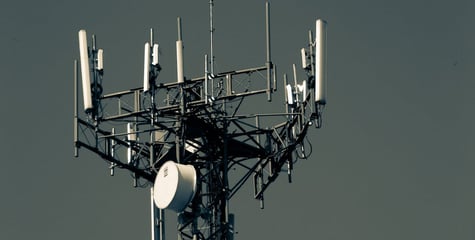IIoT networks provide businesses with enhanced operational efficiency via wireless communications between individual devices. Whether it is a sensor grid or individual devices on a production line, IIoT network applications are becoming commonplace in modern manufacturing applications.
However, IIoT has a significant challenge in the form of security when compared to its IoT counterpart. This is due to the lower power and bandwidth requirements of the network itself making it difficult to integrate sufficient security measures.
In this article, we dive into the importance of security in IIoT networks, and how antenna technologies can help protect businesses from data and security breaches.
Wireless security for IoT - how important is it?
Both IoT and IIoT networks share the same principles when it comes to their operation. Individual devices are known as nodes, and each node communicates to an access point or gateway that provides access to the organisational network. Each of these communications between nodes and access points pose a security risk via the interception of data, known as eavesdropping.
With standard IoT networks, the risk of eavesdropping is minimal. These are consumer grade networks that serve miscellaneous purposes such as those within smart homes. Additionally, these networks have high bandwidths that can support dedicated security measures to prevent data breaches. As such, there is usually little to gain from intercepting the data on these networks, with certain exceptions such as those in offices with sensitive company data.
The importance of wireless security in IIoT
IIoT networks are responsible for the interoperability of vital business operations and can include a range of sensitive information, making them a target for eavesdropping and breaches. Unfortunately, these networks are complex with limited integration for security; they can consist of thousands of individual nodes that operate via low-power and low-bandwidth communications, whereas traditional security measures require higher bandwidths and power consumption to operate.
These factors make security an integral challenge for IIoT networks. Entire factories and businesses can be halted without sufficient protection, leading to specialised solutions.
- Secure access points - It is vital for IIoT networks to have secure access points that are securely configured and can identify fraudulent connections. This includes regularly updating authentication processes and integrating sufficient security software.
- Specialised networks - Certain networks are specialised to be secure for IIoT applications. A key example is 802.1x, which is a port-based network that has authentication mechanisms to prevent fraudulent connections.
- Antenna technology - Individual nodes and hardware can play a role in enhancing IIoT network security by minimising vulnerabilities, specifically through the features and performance of antenna solutions.
An antenna’s influence on network security
Physical layer security
Nodes within an IIoT network are key vulnerabilities. They are usually small devices that have limited power consumption, meaning that available security measures are limited without risking operational performance and efficiency. Because of this, they can easily be compromised by eavesdropping and information leaks.
As a solution, physical layer security applications using multiple-antenna systems can be integrated to protect the wireless communications between nodes and access points. These additional antennas mask the transmissions between the two by using fading, noise and interference. This helps steer the confidential information towards the intended receiver whilst broadcasting an interfering signal to those trying to eavesdrop.
Directional antennas
Many nodes and devices in IIoT networks use omnidirectional antennas. This is because they are typically small, low in cost and simple to integrate, which are integral features in these networks. However, these antennas can be easily compromised as they transmit signals in all directions for eavesdroppers to intercept.
Directional antennas provide enhanced security features when compared to their omnidirectional counterparts. They concentrate their radio signals in desired directions, making them resistant to signal interception. Moreover, node position verification can be integrated, which is an additional layer of security that uses the signal’s direction of arrival as a way to validate the identity of the node against fraudulent connections.
Ensure the security of your network with high-performance antennas
The security of IIoT networks is an integral design challenge that every business looking to utilise their benefits must overcome. Fortunately, proper network installations and the integration of high performing and power efficient antennas can help streamline this challenge.
At Antenova, we provide a wide range of antenna solutions in different technologies, types and form factors to suit any IIoT network design. Our antennas showcase excellent power efficiency, high performance and compact form factors without compromising on any feature. They are also designed with integration in mind, making the process of introducing the antenna solution into your design a simple one.
To find out more about our wide range of high performance and efficiency antennas, contact a member of our team today.




